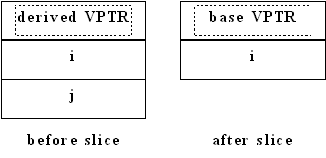
| Bruce Eckel's Thinking in C++, 2nd Ed | Contents | Prev | Next |
//: C15:Addv.cpp
// Adding virtuals in derivation
#include <iostream>
using namespace std;
class Base {
int i;
public:
Base(int ii) : i(ii) {}
virtual int value() const { return i; }
};
class Derived : public Base {
public:
Derived(int ii) : Base(ii) {}
int value() const {
return Base::value() * 2;
}
// New virtual function in the Derived class:
virtual int shift(int x) const {
return Base::value() << x;
}
};
int main() {
Base* B[] = { new Base(7), new Derived(7) };
cout << "B[0]->value() = "
<< B[0]->value() << endl;
cout << "B[1]->value() = "
<< B[1]->value() << endl;
//! cout << "B[1]->shift(3) = "
//! << B[1]->shift(3) << endl; // Illegal
//: C15:Slice.cpp
// Object slicing
#include <iostream>
using namespace std;
class Base {
int i;
public:
Base(int ii = 0) : i(ii) {}
virtual int sum() const { return i; }
};
class Derived : public Base {
int j;
public:
Derived(int ii = 0, int jj = 0)
: Base(ii), j(jj) {}
int sum() const { return Base::sum() + j; }
};
void call(Base b) {
cout << "sum = " << b.sum() << endl;
}
int main() {
Base b(10);
Derived d(10, 47);
call(b);
call(d);